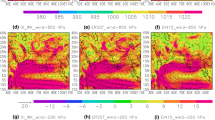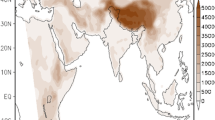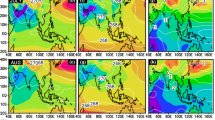Abstract
Establishment of Indian summer monsoon (ISM) rainfall passes through the different phases and is not uniformly distributed over the Indian subcontinent. This enhancement and reduction in daily rainfall anomaly over the Indian core monsoon region during peak monsoon season (i.e., July and August) are commonly termed as ‘active’ and ‘break’ phases of monsoon. The purpose of this study is to analyze REGional Climate Model (RegCM) results obtained using the most suitable convective parameterization scheme (CPS) to determine active/break phases of ISM. The model-simulated daily outgoing longwave radiation (OLR), mean sea level pressure (MSLP), and the wind at 850 hPa of spatial resolution of 0.5°× 0.5° are compared with NOAA, NCEP, and EIN15 data, respectively over the South-Asia Co-Ordinated Regional Climate Downscaling EXperiment (CORDEX) region. 25 years (1986–2010) composites of OLR, MSLP, and the wind at 850 hPa are considered from start to the dates of active/break phase and up to the end dates of active/break spell of monsoon. A negative/positive anomaly of OLR with active/break phase is found in simulations with CPSs Emanuel and Mix99 (Grell over land; Emanuel over ocean) over the core monsoon region as well as over Monsoon Convergence Zone (MCZ) of India. The appearance of monsoon trough during active phase over the core monsoon zone and its shifting towards the Himalayan foothills during break phase are also depicted well. Because of multi-cloud function over oceanic region and single cloud function over the land mass, the Mix99 CPSs perform well in simulating the synoptic features during the phases of monsoon.













Similar content being viewed by others
Abbreviations
- ISM:
-
Indian summer monsoon
- RegCM:
-
REGional Climate Model by ICTP
- CPS:
-
Convective parameterization scheme
- OLR:
-
Outgoing longwave radiation
- MSLP:
-
Mean sea level pressure
- NOAA:
-
National Oceanic and Atmospheric Administration
- NCEP:
-
National Center for Environmental Prediction
- EIN15:
-
Era-Interim
- MCZ:
-
Monsoon Convergence Zone
- CORDEX:
-
Co-Ordinated Regional Climate Downscaling EXperiment
- IMD:
-
India Meteorological Department
- IPCC:
-
Intergovernmental panel on climate change
- ICTP:
-
International Center for Theoretical Physics
- MM5:
-
Mesoscale model version 5
- BATS:
-
Biosphere-atmosphere transfer scheme
- PBL:
-
Planetary boundary layer
- ICBC:
-
Initial conditions and boundary conditions
- OISST:
-
Optimum interpolation sea surface temperature
- OI_WK:
-
OISST in weekly pattern
- NCC:
-
National Climate Centre
- Q–Q:
-
Quantile–Quantile
- SD:
-
Standard deviation
- RMSE:
-
Root mean square error
- CC:
-
Correlation-coefficient
- ECMWF:
-
European Centre for Medium-Range Weather Forecasts
- JJAS:
-
June–July–August–September
References
Achuthavarier, D., Krishnamurthy, V. (2009) Relation between Intra-seasonal and interannual variability of South Asian monsoon in the NCEP forecast system, COLA technical report, pp. 285.
Ajayamohan, R. S., & Goswami, B. N. (2007). Dependence of simulation of boreal summer tropical intra-seasonal oscillations on the simulation of seasonal mean. Journal of Atmospheric Science, 64(2), 60–478.
Allan, R. J., & Haylock, M. R. (1993). Circulation features associated with the winter rainfall decrease in southwestern Australia. Journal of Climate, 6(7), 1356–1367.
Annamalai, H., & Slingo, J. M. (2001). Active/break cycles: diagnosis of the intra-seasonal variability of the Asian summer monsoon. Climate Dynamics, 18, 85–102.
Annamalai, H., Slingo, J. M., et al. (1999). The mean evolution and variability of the Asian summer monsoon: comparison of ECMWF and NCEP-NCAR reanalyses. Monthly Weather Review Boston MA, 127(6, Pt. 2), 1157–1186.
Annamalai, H., & Sperber, K. R. (2005). Regional heat sources and the active and break phases of boreal summer intra-seasonal (30–50 days) variability. Journal of Atmospheric Science, 62, 2726–2748.
Bhate, J., Unnikrishnan, C. K., & Rajeevan, M. (2012). Regional climate model simulations of the 2009 Indian summer monsoon. Indian IJRPS, 41(4), 488–500.
Bhatla, R., & Ghosh, S. (2015). Study of break phase of Indian summer monsoon using different parameterization schemes of RegCM-4.3. International Journal Of Earth And Atmospheric Science, 2(3), 109–115.
Bhatla, R., Ghosh, S., Mandal, B., Mall, R. K., & Sharma, K. (2016). Simulation of Indian summer monsoon onset with different parameterization convection schemes of RegCM-4.3. Atmospheric Research, 176–177, 10–18.
Bhatla, R., Mohanty, U. C., Raju, P. V. S., & Madan, O. P. (2004). A study on dynamic and thermodynamic aspects of breaks in the summer monsoon over India. International Journal of Climatology, 24, 341–360.
Dash, S. K., Pattnayak, K. C., Panda, S. K., Vaddi, D., & Mamgain, A. (2014). Impact of domain size on the simulation of Indian summer monsoon in RegCM4 using mixed convection scheme and driven by HadGEM2. Climate Dynamics, 44, 961–975.
Dash, S. K., Shekhar, M. S., & Singh, G. P. (2006). Simulation of Indian summer monsoon circulation and precipitation using RegCM3. Theoretical and Applied Climatology, 86, 161–172.
De, U.S., Lele, R.R., & Natu, J.C. (1998) Breaks in southwest monsoon. Pre-Published Scientific Report No. 1998/3.
De, U. S., & Mukhopadhyay, R. K. (2002). Breaks in monsoon and related precursors. Mausam, 53, 309–318.
Dickinson, R. E., Errico, R. M., Giorgi, F., & Bates, G. T. (1989). A regional climate model for the Western United States. Climate Change, 15, 383–422.
Elguindi, N., Xunqiang, B., Giorgi, F., Nagarajan, B., Pal, J., Solmon, F., Rauscher, S., Zakey, A., & Giuliani, G. (2011) Regional climatic model RegCM user manual version 4.3. The Abdus Salam International Centre for Theoretical Physics, StradaCostiera, Trieste.
Emanuel, K. A. (1991). A scheme for representing cumulus convection in large-scale models. Journal of Atmospheric Science, 48(21), 2313–2335.
Emanuel, K. A., & Živković-Rothman, M. (1999). Development and evaluation of a convection scheme for use in climate models. Journal of Atmospheric Science, 56, 1766–1782.
Gadgil, S. (2003). The Indian monsoon and its variability. Annual Review of Earth and Planetary Sciences, 31, 429–467.
Gadgil, S., Abrol, Y. P., & SeshagiriRao, P. R. (1999). On growth and fluctuation of Indian food grain production. Current Science, 76, 548–556.
Gadgil, S., & Joseph, P. V. (2003). On breaks of Indian monsoon. Proceedings of the Indian Academy of Sciences (Earth and Planetary Sciences), 112, 529–558.
Ghosh, S., Bhatla, R., Mall, R. K., Srivastava, P. K., & Sahai, Ak. (2018). Aspect of ECMWF downscaled regional climate modeling in simulating Indian summer monsoon rainfall and its dependencies on lateral boundary conditions. Theoretical and Applied Climatology. https://doi.org/10.1007/s00704-018-2432-6.
Giorgi, F., & Bates, G. T. (1989). The climatological skill of a regional model over complex terrain. Monthly Weather Review, 117, 2325–2347.
Giorgi, F., Coppola, E., Solmon, F., Mariotti, L., Sylla, M. B., Bi, X., et al. (2012). RegCM4: model description and preliminary tests over multiple CORDEX domains. Climate Research, 52, 7–29.
Giorgi, F., Diffenbaugh, N. S., Gao, X. J., Coppola, E., Dash, S. K., Frumento, O., et al. (2008). The regional climate change hyper-matrix framework. Eos, 89(45), 445–456.
Goswami, B. B., Mukhopadhyay, P., Khairoutdinov, M., & Goswami, B. N. (2012). Simulation of Indian summer monsoon intra-seasonal oscillations in a superparameterized coupled climate model: need to improve the embedded cloud resolving model. Climate Dynamics, 41, 1497–1507.
Grell, G. A. (1993). Prognostic evaluation of assumptions used by cumulus parameterizations. Monthly Weather Review, 121(3), 764–787.
Holtslag, A. A. M., de Bruijn, E. I. F., & Pan, H. L. (1990). A high resolution air mass transformation model for short-range weather forecasting. Monthly Weather Review, 118, 1561–1575.
IPCC. (2007). Climate Change 2007. The physical science basis. Contribution of Working Group I to the Fourth Assessment Report of the Intergovernmental Panel on Climate Change. In S. Solomon, D. Qin, M. Manning, Z. Chen, M. Marquis, K. B. Averyt, M. Tignor, H. L. Miller (Eds.) (p. 996). Cambridge, UK: Cambridge University Press.
Kang, H. S., & Hong, S. Y. (2008). Sensitivity of the simulated East Asian summer monsoon climatology to four convective parameterization schemes. Journal of Geophysical Research Atmospheres, 113, 1–17.
Krishna Kumar, K., Rupa Kumar, K., Ashrit, R. G., Deshpande, N. R., & Hansen, J. W. (2004). Climate impacts on Indian Agriculture. International Journal of Climatology, 24, 1375–1393.
Krishnamurti, T. N., & Ardanuy, P. (1980). The 10 to 20-day westward propagating mode and ‘‘breaks in the monsoons’’. Tellus, 32, 15–26.
Krishnan, R., Zhang, C., & Sugi, M. (2000). Dynamics of breaks in the Indian summer monsoon. Journal of Atmospheric Science, 57, 1354–1372.
Lal, M., Meehl, G. A., & Arblaster, J. M. (2000). Simulation of Indian summer monsoon rainfall and its intra-seasonal variability in the NCAR climate system model. Regional Environmental Change, 1, 163–179.
Lau, K. M., & Chan, P. H. (1986). Aspects of the 40–50 day oscillation during the northern summer as inferred from outgoing longwave radiation. Monthly Weather Review, 114, 1354–1367.
Lawrence, D. M., & Webster, P. J. (2002). The boreal summer intra-seasonal oscillation: relationship between northward and eastward movement of convection. Journal of Atmospheric Science, 59, 1593–1606.
Li, F., Chambers, L. E., & Nicholls, N. (2005). Relationships between rainfall in the southwest of Western Australia and near-global patterns of sea-surface temperature and mean sea-level. Australian Meteorological Magazine, 54, 23–33.
Maharana, P., & Dimri, A. P. (2015). Study of intra-seasonal variability of Indian summer monsoon using a regional climate model. Climate Dynamics, 46, 1043. https://doi.org/10.1007/s00382-015-2631-0.
Mamgain, A., Mariotti, L., Coppola, E., Giorgi, F., & Dash, S. K. (2013). Sensitivity of RegCM4.3 two convection schemes on Indian summer monsoon for the South Asia CORDEX domain. EGU General Assembly Conference Abstracts, 15, 4812.
National Climate Centre (NCC) Research Report. (2013) Development and analysis of a new high spatial resolution (0.25° × 0.25°) long period (1901–2010) daily gridded rainfall data set over India. In D. S. Pai, Latha Sridhar, M. Rajeevan, O. P. Sreejith, N. S. Satbhai, B. Mukhopadhyay (Eds.) (p. 63). NCC Research Report No. 1/2013.
ParthSarthi, P., Ghosh, S., & Kumar, P. (2015). Possible Future Projection of Indian Summer Monsoon Rainfall (ISMR) with the evaluation of model performance in Coupled Model Inter-comparison Project Phase 5 (CMIP5). Global and Planetary Change, 129, 92–106.
ParthSarthi, P., Kumar, P., & Ghosh, S. (2016). Possible future rainfall over the gangetic plains (GP), India, in multi model simulations of CMIP3 and CMIP5. Theoretical and Applied Climatology, 124(3–4), 691–701. https://doi.org/10.1007/s00704-015-1447-5.
Rajeevan, M., Gadgil, S., & Bhate, J. (2010). Active and break spells of the Indian summer monsoon. Journal of Earth System Science, 119(3), 229–247.
Raju, P. V. S., Bhatla, R., Almazroui, M., & Assiri, M. (2015). Performance of convection schemes on the simulation of summer monsoon features over the South Asia CORDEX domain using RegCM-4.3. International Journal of Climatology, 35(15), 4695–4706. https://doi.org/10.1002/joc.4317.
Raju, P. V. S., Bhatla, R., & Mohanty, U. C. (2009). The evolution of mean conditions of surface meteorological fields during active/break phases of the Indian summer monsoon. Theoretical and Applied Climatology, 95, 135–149.
Ramamurthy, K. (1969) Monsoon of India: Some aspects of the ‘break’ in the Indian southwest monsoon during July and August. In Forecasting Manual 1–57 No. IV 18.3. Pune, India: India Meteorological Department.
Rao, Y. P. (1976). Southwest monsoon India Meteorological Department. Meteorological Monograph Synoptic Meteorol, 1, 367.
Reynolds, R. W., Rayner, N. A., Smith, T. M., Stokes, D. C., & Wang, W. (2002). An improved in situ and satellite SST analysis for climate. Journal of Climate, 15, 1609–1625.
Sardar, S., Ahmad, I., ShoaibRaza, S., & Irfan, N. (2012). Simulation of south Asian physical environment using various cumulus parameterization schemes of MM5. Meteorological Applications, 19, 140–151.
Sikka, D. R., & Gadgil, S. (1980). On the maximum cloud zone and the ITCZ over Indian longitudes during the southwest monsoon. Monthly Weather Review, 108, 1840–1853.
Singh, D., Tsiang, M., Rajaratnam, B., & Diffenbaugh, N. S. (2014). Observed changes in extreme wet and dry spells during the South Asian summer monsoon season. Nature Climate Change, 4, 456–461. https://doi.org/10.1038/nclimate2208.
Sinha, P., Mohanty, U. C., Kar, S. C., Dash, S. K., & Kumari, S. (2013). Sensitivity of the GCM driven summer monsoon simulations to cumulus parameterization schemes in nested RegCM3. Theoretical and Applied Climatology, 112, 285–306. https://doi.org/10.1007/s0070401207285.
Taraphdar, S., Mukhopadhyay, P., & Goswami, B. N. (2010). Predictability of Indian summer monsoon weather during active and break phases using a high resolution regional model. Geophysical Research Letters, 37, L21812.
Taylor, K. E. (2001). Summarizing multiple aspects of model performance in a single diagram. Journal of Geophysical Research, 106(D7), 7183–7192.
Umakanth, U., Kesarkar, A. P., Raju, A., & VijayaBhaskarRao, S. (2015). Representation of monsoon intra-seasonal oscillations in regional climate model: sensitivity to convective physics. Climate Dynamics, 47(3–4), 895–917. https://doi.org/10.1007/s00382-015-2878-5.
Varikoden, H. (2006) Dynamic characteristics of atmospheric boundary layer during different phases of monsoon. Doctoral Thesis. Department of Atmospheric Sciences Cochin University of Science and Technology, Lakeside Campus, Cochin, India.
Wang, B., & Rui, H. (1990). Synoptic climatology of transient tropical intra-seasonal convection anomalies: 1975–1985. Meteorology and Atmospheric Physics, 44, 43–61.
Wilk, M. B., & Gnanadesikan, R. (1968). Probability plotting methods for the analysis of data. Biometrika, 55(1), 1–17.
Acknowledgements
This work is a part of a R&D project, funded by Department of Science and Technology (DST), Govt. of India. The authors wish to thank NOAA/OAR/ESRL (Boulder, Colorado, USA; http://www.esrl.noaa.gov/psd/) and European Centre for Medium-Range Weather Forecasts (ECMWF) for providing gridded datasets. Special thanks to the International Center for Theoretical Physics (ICTP), Italy, for providing the RegCM. The Authors wish to extend their sincere gratitude to the Journal Editor and the Reviewers for their insightful comments on the paper.
Author information
Authors and Affiliations
Corresponding author
Rights and permissions
About this article
Cite this article
Bhatla, R., Ghosh, S., Mall, R.K. et al. Regional Climate Model Performance in Simulating Intra-seasonal and Interannual Variability of Indian Summer Monsoon. Pure Appl. Geophys. 175, 3697–3718 (2018). https://doi.org/10.1007/s00024-018-1886-x
Received:
Revised:
Accepted:
Published:
Issue Date:
DOI: https://doi.org/10.1007/s00024-018-1886-x




